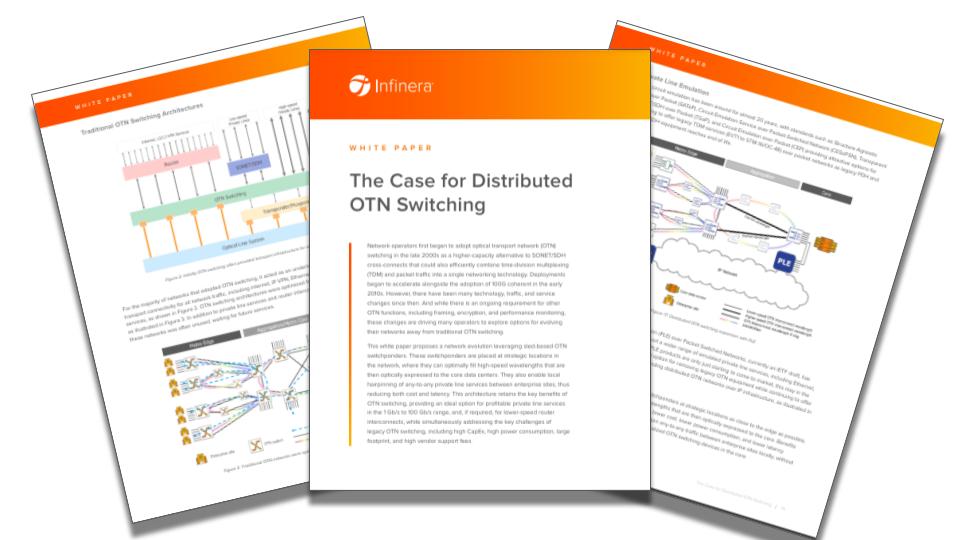The optical networking landscape continues to evolve at pace, leading to both challenges and opportunities for network owners, operators and communication service providers (CSPs). Network technology research and development continues to break ground, but this has led to many technologies that were once considered to be the most inventive of their day, being left behind.
OTN emerged in the 2000s as a next-generation of optical transmission technology. It operates on a transparent optical platform to deliver high-speed, dependable, and secure optical transmission services. OTN is sometimes referred to as a "digital wrapper" thanks to its ability to encapsulate each client or service within a container for transport across optical networks. This encapsulation is designed to preserve the original structure, timing information, and management data for the network operator or provider.
Paul Momtahan, Director of Solutions Marketing at Infinera,. He says: “CSPs invested heavily in OTN switching back in the late 2000s and early 2010s and used that as a kind of underlay to provide connectivity for everything including router interconnect, private line services, pretty much everything went over that OTN network and over those OTN switches.”
Advances in router technology
However, the last decade has brought about a lot of changes, with significant advancements in, for example, router technology, which has seen merchant routing ASICs progressing from 40nm to 7nm CMOS, and reaching speeds of 28.8Tb/s in 2023. Says Momtahan: “The routing silicon has evolved much more quickly than the OTN silicon. It's a much bigger market so it has much more investment, therefore routers have much higher capacity and lower power than OTN switches today.”
Likewise, coherent technology has undergone a transformation, with 400Gb/s pluggables reducing power consumption and cost-per-bit. Momtahan continues: “One of the big drivers for OTN switches was to make use of very expensive coherent interfaces, but the economics have changed quite dramatically now, as we move to pluggables and evolve on the coherent side.”
Then there is the change in network traffic since OTN’s initial adoption, with a significant increase in bandwidth and global internet usage growing by percentages in the thousands over the last decade. “The traffic patterns have also changed a lot,” explains Momtahan, “It has become very ‘hub-and-spoke’ as opposed to ‘any-to-any’.” Traffic used to be any-to-any carried over the OTN-switched network, while, today, it is hubbed at core data centres and peering points, largely driven by the adoption of cloud-computing.
In light of such changes, many operators and providers are now encountering challenges when it comes to legacy optical transport network switches: “These were quite large and expensive devices, and a lot of them are now coming to end of life,” says Momtahan. “They're very power hungry and there can be high vendor support fees, so there are some issues around maintaining those OTN switches in the network.”
How to maintain valuable OTN services while maintaining efficiency
But this is not a simple case of just removing and replacing the technology, despite the challenges outlined, the service they provide is still incredibly useful in a network. Momtahan explains: “Those OTN switches deliver some very valuable services, the OTN-based private line services in particular. So it's not easy to simply get rid of them. There are things that operators like about OTN and things they don’t like which creates a dilemma.”
Enter distributed OTN Switching, a concept that Infinera believes could provide a viable alternative to meet these evolving needs of CSPs. Says Momtahan: “We think we've got a good solution for operators and CSPs, which is to have an architecture based on OTN switchponders." Distributed OTN switching works with the strategic placement of compact OTN switches, (or OTN switchponders), at key locations to efficiently use upstream wavelengths and facilitate local any-to-any traffic between customer sites. Continues Momtahan: "We place OTN switchponders at a point in the network where they can efficiently aggregate traffic onto a high-speed wavelength." This strategic placement enables the aggregation of traffic while bypassing unnecessary routing through intermediate OTN stages, thereby enhancing network efficiency.
Momtahan reveals that OTN switchponders can provide all the same benefits as muxponders and OTN switches, but with the low cost, low power and small footprint of muxponders. He says: “Maxponders are cost effective, low power, small footprint, but they are basically just mapping a low speed client port onto a high speed line port. Then you have an OTN switch, which has a fabric and any-to-any switching, its granular and flexible. An OTN switchponder gives you the best of both worlds. It provides any-to-any switching, it's granular, it's flexible and it's also cost effective. It also has low power and a small footprint.”
The benefits of distributed OTN switching
The benefits of this approach can also extend beyond operational efficiency to provide operators with significant cost savings. Momtahan says: "You get lower upfront costs, space, and power, and then you can cost-effectively scale by stacking these OTN switchponders." This scalability can not only future-proof network infrastructure but also optimise resources, crucial in today's competitive optical networking landscape.
Infinera trialled this method by modelling four real-world networks, designed to compare traditional OTN switches against a solution based on this distributed OTN architecture. The work served to further validate the efficacy of distributed OTN switching as a solution. Says Momtahan: “We did all this modelling and it showed that you can get space savings up to 68%, power savings of up to 44% and capex savings up to 46%. Those savings came from the fact that we don't have switch fabrics anymore, or they’re essentially built into the cards. We don’t really have a backplane, or if we do it’s a really simple backplane and it’s going into a small, power efficient, compact modular chassis. And it's newer technology. And then from an architecture perspective, we're doing router interconnect, we're taking that off the OTN network, we're taking high speed private lines off the OTN network, and we're removing OTN nodes from the network and getting rid of the legacy platforms. So that's what's enabling all those savings.”
In addition, distributed OTN Switching aligns with broader industry trends, facilitating the evolution towards more agile and cost-effective network architectures, without losing valuable services. Momtahan says: "It's newer technology. It allows operators to continue to deliver those highly profitable OTN leased line services that specific customer segments are still demanding, but it enables them to do it in a cost-efficient, power-efficient and space-efficient way.”



